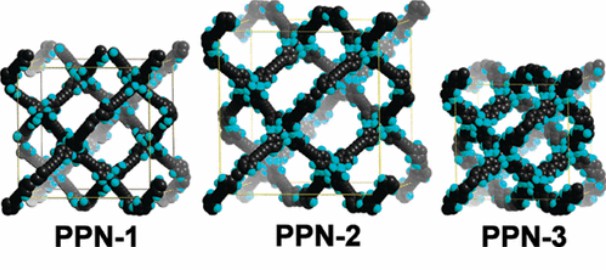Analysis of Gaseous Molecules in Polymer Materials
The fuel used by mankind has developed from solid (coal) to liquid (fossil oil) and then to gas (natural gas). In order to purify and transport gaseous fuels, new technologies related to the controlled transport of gases are needed. These technologies include the development of new polymer materials for applications such as transmission pipes, cylinders, gaskets and selective permeation membranes.
As an expert in the field of nuclear magnetic resonance, Creative Biostructure uses 129 Xe NMR to analyze the gas transmission performance of polymer materials (including adsorption, diffusion and permeation), helping customers determine the detailed correlation between gas adsorption and diffusion in polymers and high-order structural agents.
 Figure 1. Porous polymer networks for gas storage/separation (Lu et al., 2010)
Figure 1. Porous polymer networks for gas storage/separation (Lu et al., 2010)
Our Principles
Our method of analyzing polymer gas transport materials is 129 Xe NMR. Because the evaluation of the pore size, pore geometry, and pore interconnection of polymer materials is very complex, it cannot be carried out by classical spectral and diffraction techniques. One of the most effective methods to detect these parameters is the NMR spectrum of xenon, which is introduced into the pore system. It is adsorbed on the hole wall and acts as the probe core. 129 Xe has a high natural abundance of 26.4%. The nuclear spin of this isotope is 1/2, which makes it very suitable for detection in NMR spectrum. The parameters we focus on include
- The chemical shift.
- The magnetic dipole-dipole interactions between nuclear magnetic moments.
- The indirect nuclear spin-spin coupling.
- The nuclear electric quadrupolar interaction for nuclei with spin I > ½.
Our Service Content
We used 129 Xe NMR to analyze the gas transport properties (including adsorption, diffusion and permeation) of glassy polymers and rubber polymers. The detailed correlation between gas adsorption and diffusion in polymers and higher-order structural agents can be determined by NMR spectrum analysis of polymers exposed to certain gases. In addition, we can also estimate the gas diffusion characteristics based on the peak width in the polymer NMR spectrum and the data generated for customers using pulsed field gradient NMR.
Technical Features
The 129 Xe NMR chemical shift of polymeric materials can provide information about the density of rubber-like polymers or whether there are micropores in glassy materials based on qualitative and quantitative analysis. In addition, the spectral intensity can be converted into the unit of gas adsorption, and the peak width (equivalent to spin-spin relaxation time) represents the diffusion coefficient. These characteristics are independent of the evaluated atomic nucleus, indicating that various gases can be applied. Because the peak width is usually in the range of tens to tens of thousands of hertz, the gas diffusivity can be observed in a very short time scale.
Analysis of Higher-order Structure of Glassy Polymer
| Object | Method |
|---|---|
| Determination of the size and properties of micropores in glassy polymers | We used 129 Xe NMR chemical shifts to characterize the size and properties of micropores in polymer materials. |
| We used the gap between polymer chains and 129 Xe NMR porosity to determine the size of micropores in some glassy polymers. | |
| Characterization of gas adsorption degree of glassy polymer | Xe-Xe interaction is proportional to Xe density, which means the degree of Xe adsorption in the polymer. |
Analysis of Higher-order Structure of Rubber Polymer
- Analysis of the influence of temperature on gas adsorption.
- Analysis of the influence of pressure on gas adsorption.
- Prediction of diffusion coefficient from 129 Xe NMR chemical shift.
Creative Biostructure is committed to providing high-quality NMR analysis services to advance the life sciences fields. If you have any questions or needs, please contact us and our customer service staff will help you the first time.
Ordering Process
Reference
- Lu W, et al. Porous polymer networks: synthesis, porosity, and applications in gas storage/separation. Chemistry of Materials. 2010, 22(21): 5964-5972.

